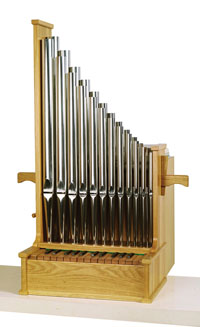2-6 Resonance in air columns
Introduction
Demo- Blow across a bottle
When you blow across the open end of a bottle, you hear the sound of certain
frequency. If
you shorten the length of the air column in the bottle by pouring some water into
the bottle, the sound you hear has higher frequency. The sound of your
blow without the bottle is much weaker and more nosier than the sound you hear
with the bottle.

The length of a pipe determines the resonant frequencies selected by the pipe;
the longer the pipe the lower the frequency of its fundamental mode.
In organs, for example, sounds of different frequencies is produced by using
pipes of different length, with some being open at both ends, other open at one
end only. When a key is pressed on the console of an organ,
air is forced through a narrow opening into a given pipe and a sound with
characteristics frequencies is heard from that pipe. Forcing air through a
narrow opening is one way of producing sound with a continuous band of frequencies
and without the pipe you hear it as a noise.
Sound
resonance in air columns plays an important role in producing sounds in some
musical instruments such as organs. In these instruments, a sound
which is a superposition of a continuous band of frequencies is generated and sent
through a pipe which reinforces only certain frequencies, the resonant
frequencies. Usually, without the help of the pipe, the sound from the source is
not loud enough to be heard over long distances. The pipe reinforces waves with
the resonant frequencies and channels more of the source energy into these waves
making them very pronounce and loud compared to other waves of the source.
Usually most of the sound energy goes into the fundamental mode, then to the
second second harmonic and so on.
